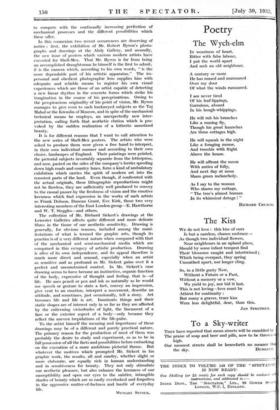Art
A Topical Motley of Graphic Art
IN this age of ours, in which the wheels of the life-machine turn with ever-increasing speed, we get tired of things far more rapidly than our fathers did some thirty years ago. We get tired of perfection perhaps even quicker than of com- parative incompetence, if that perfection does not hold anything new and progressive, and is merely a reiterated expression in superlative form of something we have known for a long time or seen often before. It is therefore with a feeling of boredom and disappointment that we leave an exhibition such as the Society of Graphic Art is holding at the Royal Institute Galleries in Piccadilly. In vain have we searched here among the three hundred and eighty-three exhibits for something that would have made a direct appeal to our sensibilities, satisfied our wish to learn or our craving for fresh emotions, spurred on our imagination or at least, be it but for a moment, roused our curiosity. That a great many of these drawings, etchings, dry-points, coloured prints, lithographs, and so forth, display most excellent craftsmanship is beyond doubt. But craftsmanship alone cannot be relied upon to incite aesthetic reactions and still less satisfy such demands, especially in the ease of graphic art which has, more than any other form of artistic technique, to compete with the continually increasing perfection of mechanical processes and the different possibilities which these offer.
In this connexion two recent occurrences are deserving of notice : first, the exhibition of Mr. Robert Byron's photo- graphs and drawings at the Abdy Gallery, and secondly, the new issue of posters which various modem artists have executed for Shell-Mex. That Mr. Byron is far from being an accomplished draughtsman he himself is the first to admit; it is the camera which, according to his own words, " is the more dependable part of his artistic apparatus." The im- personal and obedient photographic lens supplies him with adequate and reliable means to register his own visual experiences which are those of an artist capable of detecting a new linear rhythm in the concrete forms which strike his imagination in the course of his peregrinations. Owing to the perspicacious originality of his point of vision, Mr. Byron manages to give even to such hackneyed subjects as the Taj Mahal or the Kremlin of Moscow, and in spite of the mechanical technical means he employs, an unexpectedly new inter- pretation, calling forth that aesthetic elation which is pro- voked by the sudden realization of a hitherto unnoticed beauty.
It is for different reasons that I want to call attention to the new series of Shell-Mex posters. The artists who were asked to produce them were given a free hand to interpret, in their own individual manner and according to their own choice, landscapes of England. Their paintings were printed, the pictorial subjects invariably separate from the letterpress, and now, pasted on the sides of the company's lorries speeding down high roads and country lanes, form a kind of ambulatory exhibition which carries the spirit of modem art into the remotest parts of the land. Even though, if confronted with the actual originals, these lithographic reproductions might not be flawless, they are sufficiently well produced to convey to the casual passer-by the freshness of vision and the emotive keenness which find expression in the works of such artists as Frank Dobson, Duncan Grant, Eve Kirk, those two very interesting members of the East London group—E. Hawthorne and W. T. Steggles—and others.
The collection of Mr. Richard Sickert's drawings at the Leicester Galleries affects quite different and more delicate fibres in the tissue of our aesthetic sensitivity. Drawing is generally, for obvious reasons, included among the mani- festations of what is termed the graphic arts, though its practice is of a very different nature when compared with that of the mechanical and semi-mechanical media which are comprised in this category of artistic production. Drawing is alive of its own independence, and its appeal therefore is much more direct and sensual, especially when an artist as sensitive and as profound as Mr. Sickert gains over it a perfect and unconstrained control. In Mr. Sickert's case drawing seems to have become an instinctive, organic function of the body, expressive of thought and feeling, that is—of life. He uses pencil or pen and ink as naturally as he would use speech or gesture to state a fact, convey an impression, give vent to an emotion, interpret a movement, describe an attitude, and sometimes, just occasionally, tell a story. Art becomes life and life is art. Inanimate things and their static shapes are of interest only in so far as they are affected by the enlivening vicissitudes of light, the lineament of a face or the exterior aspect of a body—only because they reflect the uneven trepidations of the life-pulse.
To the artist himself the meaning and importance of these drawings may be of a different and purely practical nature. The primary reason for the production of most of them was probably the desire to study and experiment, so as to be in full possession of all the facts and possibilities before embarking on the execution of a more ambitious pictorial theme. But whatever the motives which prompted Mr. Sickert in his graphic work, the results, all and sundry, whether slight or more elaborate, are equally rich in human understanding and in sensitiveness for beauty. They not only stimulate our aesthetic pleasure, but also enhance the keenness of our susceptibility and open our eyes to the subtler, intangible shades of beauty which are so easily overlooked and forgotten in the aggressive matter-of-factness and hustle of everyday life.
MICHIAET. SEVIER.































 Previous page
Previous page